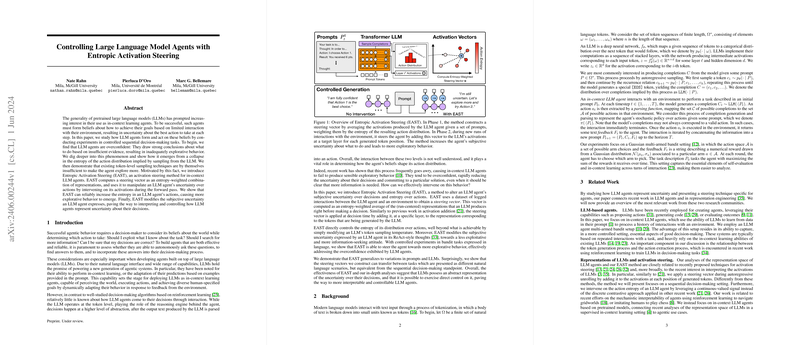Controlling LLM Agents with Entropic Activation Steering
The paper "Controlling LLM Agents with Entropic Activation Steering" by Rahn, D'Oro, and Bellemare investigates the decision-making characteristics of LLMs when they are employed as in-context learning agents. These agents are expected to make informed and adaptive decisions based on limited environmental interactions, which often leads to uncertainties regarding optimal actions. The paper reveals notable tendencies of LLM agents, such as overconfidence and insufficient exploratory behaviors, and introduces a novel method called Entropic Activation Steering (EAST) to mitigate these issues.
Overview
The large-scale utility and generality of pretrained LLMs have fostered interest in deploying them as agents capable of in-context learning. The authors conduct experiments within controlled sequential decision-making tasks to understand how LLM agents form and act upon their beliefs. They discover that LLM agents typically exhibit overconfident decision-making, drawing strong conclusions from limited evidence, which curtails effective exploration.
Key Findings
The experiments reveal that token-level sampling techniques alone cannot sufficiently enhance the explorative behavior of LLM agents. This leads to the introduction of Entropic Activation Steering (EAST), an innovative method designed to increase the action entropy of LLM agents. By manipulating the LLM's activations during its forward pass using a computed steering vector, EAST effectively intervenes on the agent's uncertainty over actions.
Experimental Findings:
- LLM agents often rapidly reduce their uncertainty over actions, causing a drop in entropy of the action distributions.
- Token-level sampling adjustments (e.g., increased temperature) have little impact on improving the exploration tendencies of these agents.
- EAST successfully increases the action entropy, leading to more balanced exploration and exploitation behaviors.
Entropic Activation Steering (EAST)
EAST comprises two main phases:
- Steering Vector Computation: Using logged interactions between the LLM agent and the environment, a steering vector is generated. This vector is an entropy-weighted combination of LLM representations immediately before decisions.
- Application of Steering Vector: During new interactions, the computed steering vector is added to the LLM agent’s activations at a specific layer and token position. This modifies the subjective uncertainty exhibited by the LLM, resulting in more explorative decisions.
Technical Implementation
The steering vector embeds an explicit representation of decision uncertainty, derived from past interactions where entropy of action distributions was calculated. This vector is continuously added to the activation layers of the LLM as it generates completions and predictions, nudging it towards more uncertain, explorative choices.
Performance Impact:
The application of EAST:
- Increased the entropy of the action distribution significantly beyond what is achievable by merely altering token sampling temperatures.
- Resulted in more explorative behaviors and less overconfidence.
- Rendered the model's thought process to be less exploitative and more information-seeking.
The robustness of EAST is demonstrated across various task descriptions and environmental conditions, proving that the steering vector encapsulates a transferable representation of uncertainty beyond specific interaction contexts.
Implications and Future Directions
The introduction of EAST has profound implications for the deployment of LLMs in automated decision-making tasks. It opens avenues for more interpretable and controllable LLM agents by showcasing that these models can hold and act on an explicit representation of uncertainty. Future research should explore:
- Generalizing EAST application to domains with continuous action spaces.
- Extending the methodology to more complex and dynamic decision-making environments.
- Integrating EAST into real-world applications, such as software engineering and tool-use scenarios, where optimal decision-making under uncertainty is crucial.
Conclusion
The authors successfully demonstrate that LLM agents, through methods like EAST, can have their inherent uncertainty and exploration behaviors effectively controlled. By presenting clear evidence that LLMs do represent and can act upon abstract uncertainties, the paper paves the way for future studies to harness these capabilities for more effective and reliable AI-driven agentic systems.
